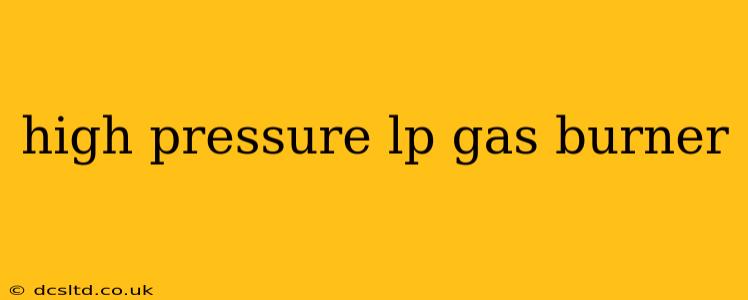High-pressure LP gas burners offer a powerful and efficient way to generate intense heat for various industrial and commercial applications. Understanding their intricacies is crucial for safe and effective operation. This guide delves into the key aspects of these burners, addressing common questions and providing valuable insights.
What is a High-Pressure LP Gas Burner?
A high-pressure LP gas burner differs from its low-pressure counterpart in its operating pressure. While low-pressure burners typically operate at pressures below 1 psi, high-pressure burners utilize significantly higher pressures, often ranging from 10 to 50 psi (or even higher depending on the application). This higher pressure allows for more precise fuel-air mixing and greater combustion efficiency, leading to a more intense and controlled flame. These burners are commonly used where high heat output and precise temperature control are essential. Applications include industrial heating processes, metalworking, and specialized cooking equipment.
How Does a High-Pressure LP Gas Burner Work?
The operation centers around precise regulation of fuel and air mixture. High-pressure LP gas is delivered through a regulator to a mixing chamber, where it is meticulously blended with air at a specific ratio. The precise mixing is crucial for optimal combustion. This mixture then flows through a nozzle, igniting to create a powerful and controlled flame. The burner design, including the nozzle size and shape, influences the flame pattern and heat distribution. Different designs cater to specific application needs, such as localized intense heat or a broader, more diffused flame.
What are the Advantages of High-Pressure LP Gas Burners?
- High Heat Output: The higher pressure allows for a significantly more intense flame compared to low-pressure systems.
- Precise Flame Control: The controlled mixture provides better flame stability and the ability to fine-tune the heat output.
- Efficient Combustion: Optimal fuel-air mixing leads to complete combustion, reducing fuel waste and minimizing emissions.
- Rapid Heating: The intense flame allows for quicker heating of materials or spaces.
- Versatile Applications: High-pressure burners are adaptable to a wide range of industrial and commercial applications.
What are the Disadvantages of High-Pressure LP Gas Burners?
- Safety Concerns: The higher pressure necessitates robust safety mechanisms and careful handling. Improper installation or maintenance can pose a significant risk.
- Higher Initial Cost: These burners are typically more expensive than low-pressure counterparts due to their more complex design and safety features.
- Specialized Installation: Proper installation often requires skilled technicians due to the higher pressure involved.
- Potential for Backfiring: While rare with proper maintenance, incorrect settings can lead to backfiring.
What are the Different Types of High-Pressure LP Gas Burners?
High-pressure LP gas burners come in various designs, each tailored to specific applications. These include:
- Premixed Burners: These burners mix the fuel and air before combustion, providing excellent flame stability and control.
- Diffusion Burners: These burners mix the fuel and air during combustion, offering a simpler design but potentially less precise control.
- Surface Combustion Burners: These burners direct the flame onto a surface, facilitating even heating.
How Safe are High-Pressure LP Gas Burners?
Safety is paramount when dealing with high-pressure gas systems. Proper installation by qualified technicians is crucial. Regular maintenance, including inspection of lines and components, is also essential. Always adhere to manufacturer instructions and local safety regulations. Automatic shutoff valves and other safety features are commonly incorporated to mitigate risks.
What are the Common Applications of High-Pressure LP Gas Burners?
High-pressure LP gas burners find applications in diverse industries, including:
- Industrial Furnaces: Providing intense heat for various industrial heating processes.
- Metalworking: Used in processes like welding, brazing, and heat treating.
- Food Processing: Used in specialized cooking equipment requiring high heat output and precise control.
- Ceramic Firing: Providing the intense heat needed for firing ceramic materials.
How Do I Choose the Right High-Pressure LP Gas Burner?
Selecting the correct burner requires careful consideration of several factors, including:
- Heat Output Requirements: Determine the amount of heat needed for the specific application.
- Flame Pattern: Choose a burner with a flame pattern suited for the application (e.g., localized intense heat or broad heat distribution).
- Pressure Requirements: Ensure the burner is compatible with the available gas pressure.
- Safety Features: Prioritize safety features such as automatic shutoff valves.
- Material Compatibility: Select a burner made of materials compatible with the gases and temperatures involved.
Understanding these factors will help you select a burner that meets your specific needs and ensures safe and efficient operation. Always consult with a gas professional for guidance on selection and installation.
